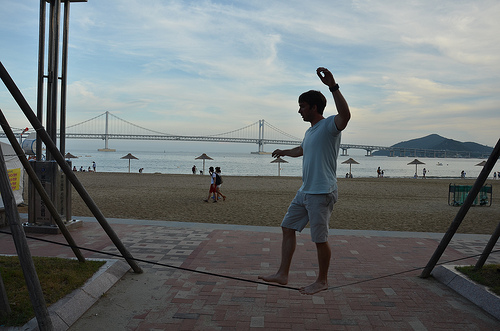
photo credit: Aug. 2013 – 3251 via photopin (license)
It’s a weekend afternoon and I’m sitting out in the front yard, looking at my slack line slung between two trees while I write this.
I was just on it a moment ago. And again several moments before that. And again several moments before that. That’s how slack lining goes for me. I do several attempts to cross its length: Sometimes I make it, sometimes I fall after a step or four or ten. After several rounds of this my balance starts to suffer as my muscles and focus fatigue, so I go sit down and take a short break, and then I go back to it, and so on.
That’s the thing that slack lining has taught me. I put it on my birthday goals list this year to try slack lining before I turned 26. In between writing it down as “try slack lining” and getting the opportunity to try it at my neighbor’s in Denver several months later, I misremembered my goal as “learn how to slack line.”
Before I had ever tried the activity, I thought of those as being pretty much the same goal. Then I thought, like many things, it may just come easily and naturally to me. When I was young we didn’t have much money and I had friends who did gymnastics. I always wanted to do it, too, but we couldn’t afford it. So my dad made a “balance beam” for us kids to do our own gymnastics on. It was a 1×4 board nailed to a base. I learned how to balance really well by the time I ever got to visit the gymnastics gym for a birthday party and walk across their real balance beam. Turns out if you learn to balance on a 1” wide board, you can balance on the 5” balance beam without problems.
But fast forward 20 years and I stepped onto the 1” wide slack line and everything on my body, and the line itself began to shake uncontrollably. I fell off as soon as I let go before I could even take one step. But in my mis-remembrance of my goal, I committed to learning how to do this.
The biggest lesson was learning how to fall. The only time I got slightly injured while slack lining was near the beginning of my learning time, and it was because when I started to fall, I tried to prevent the fall by taking another step. My second foot caught on the wobbling line and I fell body first to the ground, no feet free to land with. I hit hard hurting my tail bone and my hip.
To fall well while slacklining, you have to be aware of yourself. Aware of your balance. Aware of your core muscles and your hands lifted high for balance. You have to be able to assess if you could try to salvage your balance or, if it’s time, to just give in to the fall.
Now that I’ve been doing it for a few months, I’m still not good at slack lining, but I’m great at falling. Each fall is an act of acceptance. Falling is part of it. I step into it now, feeling the fall starting, I just step down into a walking landing. I use my momentum of those exiting steps to direct me back to the end of the line, so that I can hop up and start trying again.
When I first started trying to learn, I would thud down heavy with each fall. Sometimes it would hurt my feet. Sometimes I’d try to stay on the line longer while I fell, not ready to accept defeat for that try. It is with the acceptance of loss, the acceptance of failure that I’ve begun to make headway and begun to spend more time on the line than off of it.
It’s a dance. On the line, falling, salvage it, falling again, I accept it, I take the step off while walking to the beginning and then I’m up, at it again.
It’s become clear to me that success at this activity, and in life, has less to do with how often you fail and fall, and more to do with whether you fall well and continue to head right back to try again.
I’m 25, and after knowing the gut-wrenching ache of loss of the big things in life, I’ve begun to notice that when littler things go wrong, I hold everything very loosely. As my muscles get stronger and I get more focus, I can sometimes salvage the fall, I can sometimes correct in time to stay on the line, I can also see when it’s worth it to just give in to the fall and use the momentum to keep moving forward to try again.
I thought I was learning the art of slack lining, but I’ve learned that failing and falling and persistence are the art.
Success and slack lining are what come as a result of doing the other three well.
If you’d like to support the Story Project (to cover travel expenses, costs of Stories for those who can’t afford it, etc.) you can do so below or contact me at storyofjoblog@gmail.com if you’d like to send a check. Thank you for your support!
To Donate to Stories By Jo: The Story Project click below
Jo O’Hanlon is an adventurer and storyteller. She tries to be honest about the ugly and hard parts of life, and the beautiful parts too. This blog is one of the places she shares her thoughts and stories.
Other places are
instagram: @jrolicious twitter: @jrohanlon storyofjoblog@gmail.com